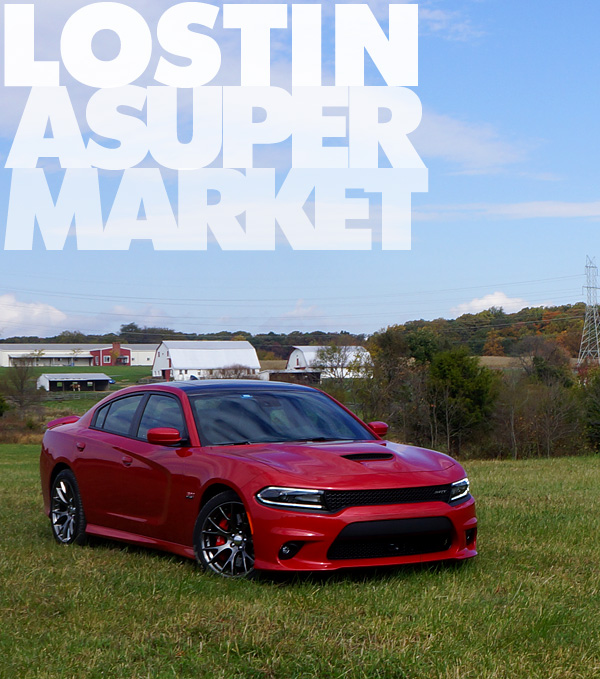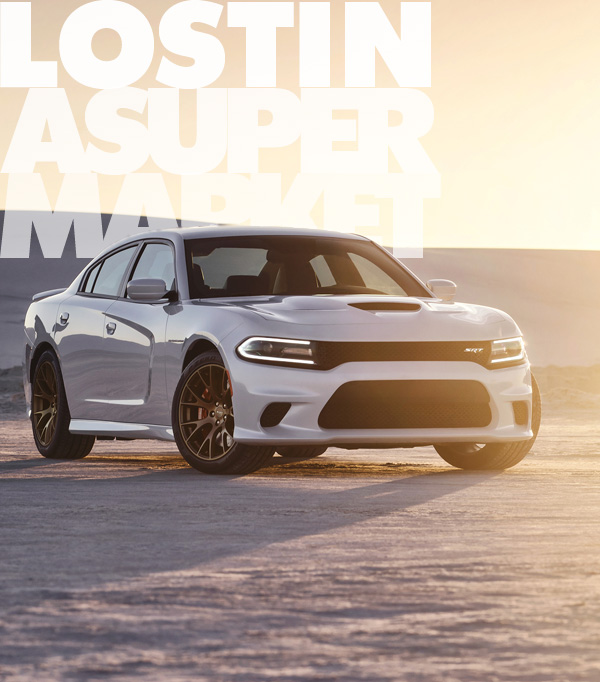Dodge’s performance arm, SRT, transplants the supercharged iron block HEMI V8 from this summer’s ludicrous 707-horsepower Challenger Hellcat — the most powerful and fastest American muscle car ever built — and shoehorns it into their four-door full-size sedan. Let the madness begin.
There is no greater luxury than power. And because of this simple metric, Dodge SRT has instantly cannonballed into the deep end of the pool. Warn the big boys, the town hooligan’s gone through puberty.
Crackling and popping with 707 horses and 650 lb-ft of brute torque from the massive 6.2-liter V8, the Dodge Charger SRT Hellcat radiates on a level unoccupied by any other sedan in the world. It’s a truly singular machine, not of this planet. Like similarly powered species — e.g. Lamborghini Aventador, Rolls-Royce Wraith, Aston Martin V12 Vantage S, Bentley GT Speed — you’d think it might be an anxious show pony. A fragile trophy to be brought out and showcased with the frequency of an aging diva. And yet, what truly makes the Charger SRT Hellcat a remarkable machine is just how livable it is. It is an exceptional daily driver.
Taking the Hellcat across two distinctly compartmentalized environs — through the suburbs of Washington D.C. and rural backroads of the Virginias, and then on the twisty asphalt of the Summit Point Raceway in West Virginia — what you experience is two temperamentally different animals.
On the backroads, dialed down to more human “Street” settings, the Hellcat drives like a comfortable quotidian commuter… one with an absurd amount of power a foot tap away, that is. But that power is tempered by firm, precise steering and enormous Brembo brakes (15.4-inch rotors with six-piston calipers) that keep you feeling secure. The suspension also deserves special acclaim, as its Bilstein adaptive shocks can be modulated to offer a more forgiving ride, or firmed up on the track to deliver terse rigidity. The adaptive dampers aren’t as fluid (or expensive) as magnetic ones, but the hydraulics are more than sufficient to change the complexion of the Charger.
“Three years ago we really wanted to push the Charger and the Challenger apart, and not just have the Charger be a four-door Challenger, or vice versa. We wanted the Challenger to be a gnarly muscle car, and it is, but we really thought we could make the Charger into a true sport sedan that can compete with the sport sedans from Europe,” explains Erich Heuschele, Manager of SRT Vehicles. “Yes we have more output, but compared to a 500-horsepopwer Jag or an AMG you have the ride comfort, the NVH. A gnarly muscle car is fun, but that’s not the car for everybody. We aimed to make [the Charger] into a legitimate, high-end sports sedan.”
Hit the Jump to continue reading the LIAS Dodge Charger SRT Hellcat Testdrive…
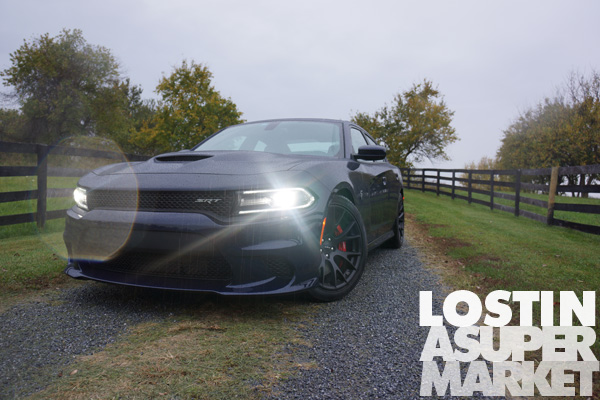
“The 6.2-liter supercharged V8 filled the cabin with the sort of terror you only hear in Godzilla films…”
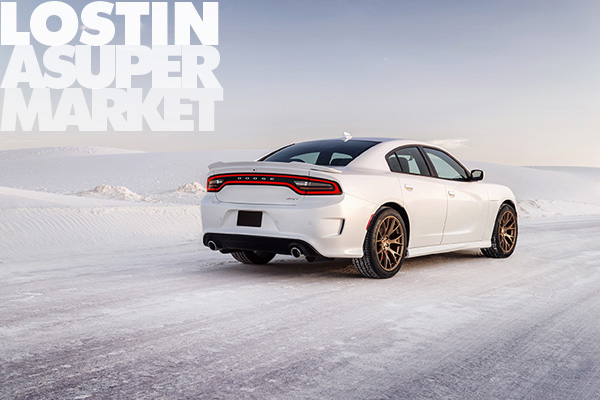
Hence Dodge invested in substantially more NVH (road noise) treatment, with more insulation and a slightly quieter supercharger. The Hellcat Charger also has its own spring rates and softer sway bars (the Challenger’s being twice as stiff), unique shock tuning, etc. to give each car its own personality.
“In the philosophy of tuning cars, we’re trying to maximize the envelope of the Charger within the character of the vehicle. What we gave up for in roll stiffness, we got more in ride, luxurious handling and day-to-day ridability,” continues Heuschele proudly. “If you drive it with finesse, like you’re supposed to drive a car on a track, and manage the tire grip, you actually have more mid-cornering speed.”
But lest you think the SRT Charger is a purring pussycat, think again. Once we made our way onto the Summit Point racetrack, we experienced the Hellcat in its more feral state. The first set of laps we took subdued, so respectful of the Hellcat’s 707 horses were we. But as we grew accustomed to the racetrack, our confidence in the Hellcat also grew. Compared to the Challenger, the Charger’s longer wheelbase offered significantly more stability on corners. Its Pirelli P-Zero Nero tires — created exclusively for the Hellcat, and the only four-season road tires rated for 200+ mph — stuck unyielding on corners. Perhaps the suspension wasn’t as stiff as the Challenger’s, but we felt no noticeable rolling of the chassis.
And when we hit the big straight and dropped the pedal, that familiar roar from the 6.2-liter V8 filled the cabin with the sort of terror you only hear in Godzilla films. Not only did we feel safe as the needle climbed over the 140-mph hashmark, but we felt equally as secure letting the Brembos scrub speed as we barreled towards Turn 1. For a bulky car that hits 204 mph, and tackles the quarter-mile in 11 seconds flat, that sense of security is critical.
Given its gas pedal, which has a long travel allowing for sensitive manipulation of petroleum injection, driving the Charger Hellcat on such a racetrack is an exercise in skill sharpening. The car is not riddled with electronic aids to keep you on the road; set on Track, almost all traction control is removed. You make a mistake, you’ll know. But if you stay within your pay grade, you are rewarded with an immense sense of satisfaction. Of knowing, when handled properly, that you are capable of taming a 700+ horsepower demonic beast.
“That’s just a philosophy we have: these cars don’t drive themselves. If you drive like a chump, it’s gonna show. If you’re really good at driving, it’s gonna show,” Heuschele reminds me after numerous laps. “There’s a little bit of Viper in there, too — this isn’t a car for amateurs to make everybody look like a pro, this is a car when people improve their skill set, you really benefit.”
As for looks, count me as one of the initial critics of the recent Charger facelift. When first debuted at the New York Auto Show this past April, the mid-cycle refresh lacked the scowling headlamps and general bad assery of the initial seventh generation model. And in base form that problem persists. But in SRT versions, significant changes were made that heighten the aggressiveness of the 2015 Charger.

Most saliently, the grill looks infinitely better in SRT garb, exorcising the signature crossfire design in lieu of a black, unbroken horizontal bar with honeycomb grill pattern that brings the Charger closer to its Camaro and Mustang muscle car nemeses. An emphasis on aerodynamic downforce to keep the car stable at ludicrous speeds resulted in a redesigned fascia, large diffuser, more pronounced brow, three-part rear spoiler, side skirts, etc. Combined with the parenthetical LED daytime running lights penetrating from the darkness, functional hood air scoops and 20-inch rims, and the SRT Chargers leapfrog their German rivals in concentrated menace.
Oh, and now it’s got an exclusive “Hellcat” screaming kitty badge behind the front wheels to let everyone know, without a doubt, that they’re in the presence of greatness.
No, the aesthetics don’t bring the Charger Hellcat into the realm of the BMW M5 or AMG E63, but they instead elevate the car into its own world, its own rarefied segment. Part obnoxious American muscle car, part considerate family car, part sexually charged sports sedan. Let’s not forget significant European blood pumps through Dodge’s corpus, both from its earlier Daimler ownership and its present Fiat partnership.
The one place where the Charger Hellcat does fall short of its European rivals is the interior. It’s not that Dodge/Chrysler hasn’t taken significant steps to improve their greatest deficit, they have. A new radio, TFT gauge cluster, 8.4-inch touchscreen display, Nappa leather and Alcantara seats and a stickshift with the haptic feel of a gated shifter have been introduced. Interior touch points have been upgraded, and 19 color and material combinations are available for the interior. But there are still acres of uninterrupted plastics spanning the dashboard, and everything just looks a bit unfinished. Maybe the town hooligan has gone through puberty, but he’s still got some knobby knees and pimples to work through.
The Charger Hellcat’s interior design suffers from the same issue that plagues the Challenger Hellcat: What is eminently passable in a $30,000 car comes across as sub-par in a $60K+ car, especially one this singular.
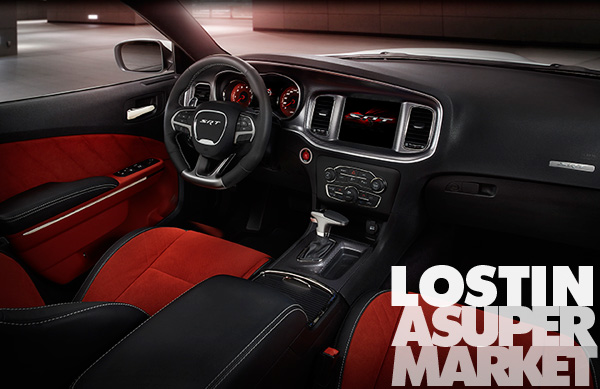
However for the $63,995 base pricetag we’re nitpicking. When you’ve engineered the quickest, fastest, and most powerful production sedan the world has ever seen, for a quarter of the cost of a similarly powered European vehicle, there are corners that will need to be cut. And if that’s in the dashboard design, so be it. A family car that surpasses 200 mph?! Pure lunacy. But a commendable — and well-executed — lunacy.
The Big Question:
Sure the Charger trounces the competition in every important power metric there exists, but does it have the refinement and styling to really threaten its German nemeses?
The More You Know:
There is a slightly less powerful SRT Charger “392” offered, with still exceptional 485-HP and 475 lb-ft of torque, 8-speed transmission, Bilstein adaptive shocks, bodywork and Brembo brakes. It’s the sweet spot in the Charger line-up, and in many ways the best value option.
Fact Check:
Dodge has a tradition of naming their engines after WWII-era aircraft, which is where the infernal Hellcat names derives: the carrier-based Grumman F6F Hellcat fighter plane. So does the second-tier SRT 392, whose “Apache” engine is named after the A-36 Apache — a dive-bombing alternate of the P-51 Mustang.
